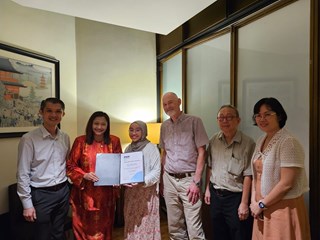Pioneering Bedside Imaging: The Journey of Nadia Mohd Shahrom from the Universiti Malaya to IPEM Student Prize Winner

Nadia Mohd Shahrom graduated from the Universiti Malaya with a Master of Medical Physics in 2023. She was one of the 2023 IPEM Masters Level Accreditation Framework (MLAF) Student Prize winners. The Dean of the Faculty of Medicine, Dato’ Professor Dr Yang Faridah Abdul Aziz, presented her with the certificate during the visit of Emeritus Professor Alan Perkins (one of Nadia's supervisors) to the university in June 2024.
With the support and encouragement from experienced and dedicated lecturers, coupled with the comprehensive modules offered by the course, she developed a strong enthusiasm for learning and exploring new knowledge. She progressed to become one of the best oral presenters at the Malaysia Nuclear Medicine (MyNM) Conference 2023 and is currently working as a medical physicist in a clinical setting.

Her project, which advances the field of nuclear medicine, is titled “Characterisation for a Novel Hybrid Optical Gamma Camera - SERACAM”. This project was conducted in collaboration with Serac Imaging System Ltd., based in the United Kingdom, under the supervision of Dr Aik Hao Ng (Universiti Malaya), Professor Chai Hong Yeong (Taylors' University), and Professor Alan Perkins (University of Nottingham). SERACAM is a small field of view (SFOV) hybrid gamma-optical camera designed to evolve the conventional gamma camera into a portable device, feasible for use outside of the nuclear medicine department, particularly in the operating theatre (for sentinel lymph node localisation) and to promote bedside imaging to improve patient comfort. The characterisation work involved testing spatial resolution, sensitivity, count rate performance, uniformity, and detector head leakage.
Overall, the findings concluded that the spatial resolution of the camera is higher compared to conventional gamma cameras, but with lower sensitivity due to the use of a pinhole collimator. Imaging performance tests were carried out using a head and neck phantom containing either Iodine-131 or Technetium-99m radionuclides to mimic clinical situations, with image processing and analysis performed using ImageJ. The performance of SERACAM has been successfully characterised and tested, paving the way for its future use in clinical settings for bedside imaging
The Master of Medical Physics programme offered by the Universiti Malaya is a postgraduate programme designed to equip students with the expertise to integrate physics with medical applications for diagnostic and therapeutic purposes. The programme encompasses a broad range of subjects, including radiation physics, medical imaging, radiation therapy, and radiation safety. The coursework is complemented by clinical placements at a teaching hospital, providing hands-on experience in real-world clinical settings.